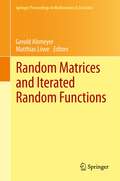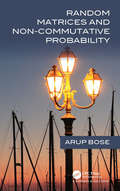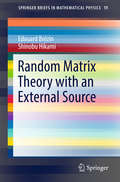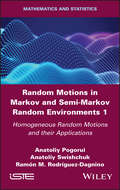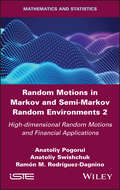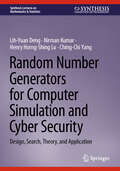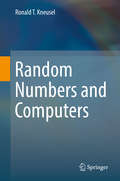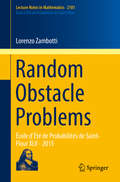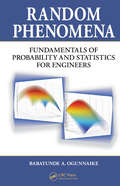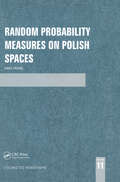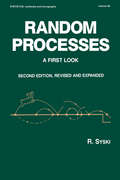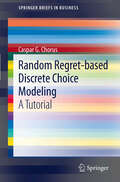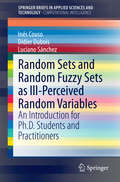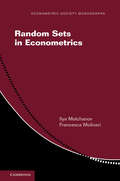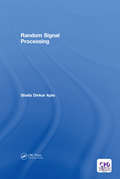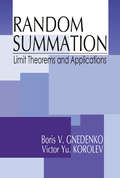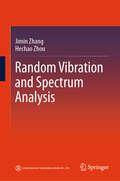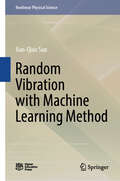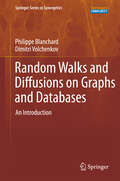- Table View
- List View
Random Matrices and Iterated Random Functions: Münster, October 2011
by Gerold Alsmeyer Matthias LöweRandom Matrices are one of the major research areas in modern probability theory, due to their prominence in many different fields such as nuclear physics, statistics, telecommunication, free probability, non-commutative geometry, and dynamical systems. A great deal of recent work has focused on the study of spectra of large random matrices on the one hand and on iterated random functions, especially random difference equations, on the other. However, the methods applied in these two research areas are fairly dissimilar. Motivated by the idea that tools from one area could potentially also be helpful in the other, the volume editors have selected contributions that present results and methods from random matrix theory as well as from the theory of iterated random functions. This work resulted from a workshop that was held in Münster, Germany in 2011. The aim of the workshop was to bring together researchers from two fields of probability theory: random matrix theory and the theory of iterated random functions. Random matrices play fundamental, yet very different roles in the two fields. Accordingly, leading figures and young researchers gave talks on their field of interest that were also accessible to a broad audience.
Random Matrices and Non-Commutative Probability
by Arup BoseThis is an introductory book on Non-Commutative Probability or Free Probability and Large Dimensional Random Matrices. Basic concepts of free probability are introduced by analogy with classical probability in a lucid and quick manner. It then develops the results on the convergence of large dimensional random matrices, with a special focus on the interesting connections to free probability. The book assumes almost no prerequisite for the most part. However, familiarity with the basic convergence concepts in probability and a bit of mathematical maturity will be helpful. Combinatorial properties of non-crossing partitions, including the Möbius function play a central role in introducing free probability. Free independence is defined via free cumulants in analogy with the way classical independence can be defined via classical cumulants. Free cumulants are introduced through the Möbius function. Free product probability spaces are constructed using free cumulants. Marginal and joint tracial convergence of large dimensional random matrices such as the Wigner, elliptic, sample covariance, cross-covariance, Toeplitz, Circulant and Hankel are discussed. Convergence of the empirical spectral distribution is discussed for symmetric matrices. Asymptotic freeness results for random matrices, including some recent ones, are discussed in detail. These clarify the structure of the limits for joint convergence of random matrices. Asymptotic freeness of independent sample covariance matrices is also demonstrated via embedding into Wigner matrices. Exercises, at advanced undergraduate and graduate level, are provided in each chapter.
Random Matrix Theory with an External Source
by Edouard Brézin Shinobu HikamiThis is a first book to show that the theory of the Gaussian random matrix is essential to understand the universal correlations with random fluctuations and to demonstrate that it is useful to evaluate topological universal quantities. We consider Gaussian random matrix models in the presence of a deterministic matrix source. In such models the correlation functions are known exactly for an arbitrary source and for any size of the matrices. The freedom given by the external source allows for various tunings to different classes of universality. The main interest is to use this freedom to compute various topological invariants for surfaces such as the intersection numbers for curves drawn on a surface of given genus with marked points, Euler characteristics, and the Gromov-Witten invariants. A remarkable duality for the average of characteristic polynomials is essential for obtaining such topological invariants. The analysis is extended to nonorientable surfaces and to surfaces with boundaries.
Random Motions in Markov and Semi-Markov Random Environments 1: Homogeneous Random Motions and their Applications
by Anatoliy Swishchuk Anatoliy Pogorui Ramon M Rodriguez-DagninoThis book is the first of two volumes on random motions in Markov and semi-Markov random environments. This first volume focuses on homogenous random motions. This volume consists of two parts, the first describing the basic concepts and methods that have been developed for random evolutions. These methods are the foundational tools used in both volumes, and this description includes many results in potential operators. Some techniques to find closed-form expressions in relevant applications are also presented. The second part deals with asymptotic results and presents a variety of applications, including random motion with different types of boundaries, the reliability of storage systems and solutions of partial differential equations with constant coefficients, using commutative algebra techniques. It also presents an alternative formulation to the Black-Scholes formula in finance, fading evolutions and telegraph processes, including jump telegraph processes and the estimation of the number of level crossings for telegraph processes.
Random Motions in Markov and Semi-Markov Random Environments 2: High-dimensional Random Motions and Financial Applications
by Anatoliy Swishchuk Anatoliy Pogorui Ramon M. Rodriguez-DagninoThis book is the second of two volumes on random motions in Markov and semi-Markov random environments. This second volume focuses on high-dimensional random motions. This volume consists of two parts. The first expands many of the results found in Volume 1 to higher dimensions. It presents new results on the random motion of the realistic three-dimensional case, which has so far been barely mentioned in the literature, and deals with the interaction of particles in Markov and semi-Markov media, which has, in contrast, been a topic of intense study. The second part contains applications of Markov and semi-Markov motions in mathematical finance. It includes applications of telegraph processes in modeling stock price dynamics and investigates the pricing of variance, volatility, covariance and correlation swaps with Markov volatility and the same pricing swaps with semi-Markov volatilities.
Random Number Generators for Computer Simulation and Cyber Security: Design, Search, Theory, and Application (Synthesis Lectures on Mathematics & Statistics)
by Ching-Chi Yang Nirman Kumar Lih-Yuan Deng Henry Horng-Shing LuThis book discusses the theory and practice of random number generators that are useful for computer simulation and computer security applications. Random numbers are ubiquitous in computation. They are used in randomized algorithms to perform sampling or choose randomly initialized parameters or perform Markov Chain Monte Carlo (MCMC). They are also used in computer security applications for various purposes such as cryptographic nuances or in authenticators. In practice, the random numbers used by any of these applications are from a pseudo-random sequence. These pseudo-random sequences are generated by RNGs (random number generators). This book discusses the theory underlying such RNGs, which are used by all programmers. However, few try to understand the theory behind them. This topic is an active area of research, particularly when the generators are used for cryptographic applications. The authors introduce readers to RNGs, how they are judged for quality, the mathematical and statistical theory behind them, as well as provide details on how these can be implemented in any programming language. The book discusses non-linear transformations that use classical linear generators for cryptographic applications and how to optimize to make such generators more efficient. In addition, the book provides up-to-date research on RNGs including a modern class of efficient RNGs and shows how to search for new RNGs with good quality and how to parallelize these RNGs.
Random Numbers and Computers
by Ronald T. KneuselThis book covers pseudorandom number generation algorithms, evaluation techniques, and offers practical advice and code examples. Random Numbers and Computers is an essential introduction or refresher on pseudorandom numbers in computer science. The first comprehensive book on the topic, readers are provided with a practical introduction to the techniques of pseudorandom number generation, including how the algorithms work and how to test the output to decide if it is suitable for a particular purpose. Practical applications are demonstrated with hands-on presentation and descriptions that readers can apply directly to their own work. Examples are in C and Python and given with an emphasis on understanding the algorithms to the point of practical application. The examples are meant to be implemented, experimented with and improved/adapted by the reader.
Random Obstacle Problems
by Lorenzo ZambottiStudying the fine properties of solutions to Stochastic (Partial) Differential Equations with reflection at a boundary, this book begins with a discussion of classical one-dimensional diffusions as the reflecting Brownian motion, devoting a chapter to Bessel processes, and moves on to function-valued solutions to SPDEs. Inspired by the classical stochastic calculus for diffusions, which is unfortunately still unavailable in infinite dimensions, it uses integration by parts formulae on convex sets of paths in order to describe the behaviour of the solutions at the boundary and the contact set between the solution and the obstacle. The text may serve as an introduction to space-time white noise, SPDEs and monotone gradient systems. Numerous open research problems in both classical and new topics are proposed.
Random Patterns and Structures in Spatial Data
by Radu StoicaThe book presents a general mathematical framework able to detect and to characterise, from a morphological and statistical perspective, patterns hidden in spatial data. The mathematical tools employed are Gibbs Markov processes, maily marked point procesess with interaction, which permits us to reduce the complexity of the pattern. It presents the framework, step by step, in three major parts: modeling, simulation, and inference. Each of these parts contains a theoretical development followed by applications and examples.Features Presents mathematical foundations for tackling pattern detection and characterisation in spatial data using marked Gibbs point processes with interactions Includes application examples from cosmology, environmental sciences, geology, and social networks Presents theoretical and practical details for the presented algorithms in order to be correctly and efficiently used Provides access to C++ and R code to encourage the reader to experiment and to develop new ideas Includes references and pointers to mathematical and applied literature to encourage further study Random Patterns and Structures in Spatial Data is primarily aimed at researchers in mathematics, statistics, and the above-mentioned application domains. It is accessible for advanced undergraduate and graduate students and thus could be used to teach a course. It will be of interest to any scientific researcher interested in formulating a mathematical answer to the always challenging question: what is the pattern hidden in the data?
Random Phenomena: Fundamentals of Probability and Statistics for Engineers
by Babatunde A. OgunnaikeMany of the problems that engineers face involve randomly varying phenomena of one sort or another. However, if characterized properly, even such randomness and the resulting uncertainty are subject to rigorous mathematical analysis. Taking into account the uniquely multidisciplinary demands of 21st-century science and engineering, Random Phenomena
Random Probability Measures on Polish Spaces (Stochastic Monographs #Vol. 11)
by Hans CrauelIn this monograph the narrow topology on random probability measures on Polish spaces is investigated in a thorough and comprehensive way. As a special feature, no additional assumptions on the probability space in the background, such as completeness or a countable generated algebra, are made. One of the main results is a direct proof of the rando
Random Processes for Engineers
by Bruce HajekThis engaging introduction to random processes provides students with the critical tools needed to design and evaluate engineering systems that must operate reliably in uncertain environments. A brief review of probability theory and real analysis of deterministic functions sets the stage for understanding random processes, whilst the underlying measure theoretic notions are explained in an intuitive, straightforward style. Students will learn to manage the complexity of randomness through the use of simple classes of random processes, statistical means and correlations, asymptotic analysis, sampling, and effective algorithms. Key topics covered include: - Calculus of random processes in linear systems - Kalman and Wiener filtering - Hidden Markov models for statistical inference - The estimation maximization (EM) algorithm - An introduction to martingales and concentration inequalities. Understanding of the key concepts is reinforced through over 100 worked examples and 300 thoroughly tested homework problems (half of which are solved in detail at the end of the book).
Random Processes: A First Look, Second Edition,
by SyskiThis book develops appreciation of the ingenuity involved in the mathematical treatment of random phenomena, and of the power of the mathematical methods employed in the solution of applied problems. It is intended to students interested in applications of probability to their disciplines.
Random Regret-based Discrete Choice Modeling: A Tutorial
by Caspar G. ChorusThis tutorial presents a hands-on introduction to a new discrete choice modeling approach based on the behavioral notion of regret-minimization. This so-called Random Regret Minimization-approach (RRM) forms a counterpart of the Random Utility Maximization-approach (RUM) to discrete choice modeling, which has for decades dominated the field of choice modeling and adjacent fields such as transportation, marketing and environmental economics. Being as parsimonious as conventional RUM-models and compatible with popular software packages, the RRM-approach provides an alternative and appealing account of choice behavior. Rather than providing highly technical discussions as usually encountered in scholarly journals, this tutorial aims to allow readers to explore the RRM-approach and its potential and limitations hands-on and based on a detailed discussion of examples. This tutorial is written for students, scholars and practitioners who have a basic background in choice modeling in general and RUM-modeling in particular. It has been taken care of that all concepts and results should be clear to readers that do not have an advanced knowledge of econometrics.
Random Sets and Random Fuzzy Sets as Ill-Perceived Random Variables
by Didier Dubois Inés Couso Luciano SánchezThis short book provides a unified view of the history and theory of random sets and fuzzy random variables, with special emphasis on its use for representing higher-order non-statistical uncertainty about statistical experiments. The authors lay bare the existence of two streams of works using the same mathematical ground, but differing form their use of sets, according to whether they represent objects of interest naturally taking the form of sets, or imprecise knowledge about such objects. Random (fuzzy) sets can be used in many fields ranging from mathematical morphology, economics, artificial intelligence, information processing and statistics per se, especially in areas where the outcomes of random experiments cannot be observed with full precision. This book also emphasizes the link between random sets and fuzzy sets with some techniques related to the theory of imprecise probabilities. This small book is intended for graduate and doctoral students in mathematics or engineering, but also provides an introduction for other researchers interested in this area. It is written from a theoretical perspective. However, rather than offering a comprehensive formal view of random (fuzzy) sets in this context, it aims to provide a discussion of the meaning of the proposed formal constructions based on many concrete examples and exercises. This book should enable the reader to understand the usefulness of representing and reasoning with incomplete information in statistical tasks. Each chapter ends with a list of exercises.
Random Sets in Econometrics (Econometric Society Monographs #60)
by Ilya Molchanov Francesca MolinariRandom set theory is a fascinating branch of mathematics that amalgamates techniques from topology, convex geometry, and probability theory. Social scientists routinely conduct empirical work with data and modelling assumptions that reveal a set to which the parameter of interest belongs, but not its exact value. Random set theory provides a coherent mathematical framework to conduct identification analysis and statistical inference in this setting and has become a fundamental tool in econometrics and finance. <P>This is the first book dedicated to the use of the theory in econometrics, written to be accessible for readers without a background in pure mathematics. Molchanov and Molinari define the basics of the theory and illustrate the mathematical concepts by their application in the analysis of econometric models. The book includes sets of exercises to accompany each chapter as well as examples to help readers apply the theory effectively.<P>Remains accessible for the average reader without advanced knowledge in mathematics.<P> Includes examples of applications to some important problems in econometrics, offering a blue-print for how to apply the techniques in different models.<P> Provides sets of exercises to accompany each chapter.
Random Signal Processing
by Shaila Dinkar ApteThis book covers random signals and random processes along with estimation of probability density function, estimation of energy spectral density and power spectral density. The properties of random processes and signal modelling are discussed with basic communication theory estimation and detection. MATLAB simulations are included for each concept with output of the program with case studies and project ideas. The chapters progressively introduce and explain the concepts of random signals and cover multiple applications for signal processing. The book is designed to cater to a wide audience starting from the undergraduates (electronics, electrical, instrumentation, computer, and telecommunication engineering) to the researchers working in the pertinent fields. <P><P> Key Features: <li>Aimed at random signal processing with parametric signal processing-using appropriate segment size. <li>Covers speech, image, medical images, EEG and ECG signal processing. <li> Reviews optimal detection and estimation. <li>Discusses parametric modeling and signal processing in transform domain. <li>Includes MATLAB codes and relevant exercises, case studies and solved examples including multiple choice questions
Random Summation: Limit Theorems and Applications
by Boris V. Gnedenko Victor Yu. KorolevThis book provides an introduction to the asymptotic theory of random summation, combining a strict exposition of the foundations of this theory and recent results. It also includes a description of its applications to solving practical problems in hardware and software reliability, insurance, finance, and more. The authors show how practice interacts with theory, and how new mathematical formulations of problems appear and develop.Attention is mainly focused on transfer theorems, description of the classes of limit laws, and criteria for convergence of distributions of sums for a random number of random variables. Theoretical background is given for the choice of approximations for the distribution of stock prices or surplus processes. General mathematical theory of reliability growth of modified systems, including software, is presented. Special sections deal with doubling with repair, rarefaction of renewal processes, limit theorems for supercritical Galton-Watson processes, information properties of probability distributions, and asymptotic behavior of doubly stochastic Poisson processes.Random Summation: Limit Theorems and Applications will be of use to specialists and students in probability theory, mathematical statistics, and stochastic processes, as well as to financial mathematicians, actuaries, and to engineers desiring to improve probability models for solving practical problems and for finding new approaches to the construction of mathematical models.
Random Variables for Scientists and Engineers (Synthesis Lectures on Engineering, Science, and Technology)
by Ramalingam Shanmugam Rajan ChattamvelliThis book provides an introductory overview of random variables and their transformations. The authors approach the topic with statistics students in mind, along with researchers in various fields who are interested in data analysis. The book begins with by defining and explaining mathematical expectation. The authors then discuss transformations of random variables, including distribution functions and special functions. The book also covers joint probability distribution and its applications. The authors have updated and expanded upon their writing on these topics, which they originally covered in their previous book, Statistics for Scientists and Engineers.
Random Vibration and Spectrum Analysis
by Jimin Zhang Hechao ZhouThis book provides an in-depth exploration of random vibration and spectral analysis theory, while emphasizing the completeness of knowledge. It incorporates fundamental theories related to the book's content, drawing from various fields such as theoretical mechanics, material mechanics, mechanical vibration, and engineering mathematics. The focus is on studying and solving the problem of random vibration response analysis in mechanical systems, locomotives, vehicles, and other engineering disciplines.The content includes fundamentals of vibration, probability theory, random variables and random processes, spectral analysis, transfer characteristics of single-degree-of-freedom and multi-degree-of-freedom random vibrations, and random vibration of rail transit vehicles. The book also presents essential theories and methods such as integral transforms, correlation analysis of random vibrations, spectral analysis, random excitation-response analysis of linear systems, statistical characterization of random responses, and random vibration analysis.
Random Vibration with Machine Learning Method (Nonlinear Physical Science)
by Jian-Qiao SunThe book presents the theoretical foundation of random vibration of dynamic systems and new machine learning methods for the analysis of linear and nonlinear random vibration problems. This is the first book on the market that introduces the tools of artificial intelligence, i.e. neural networks, to engineering problems of random vibration. The first part of the book briefly reviews probability theory, stochastic processes, spectral analysis of stochastic processes, stochastic calculus, and a brief and general discussion of the response process viewed as a mapping of random excitation and uncertainties, equations for response probability distribution and reliability problems. The second part of the book presents studies of linear and nonlinear random vibration problems. In particular, the radial basis neural networks solution is introduced. Extensive examples are presented to demonstrate the neural network solution. Data-driven random vibration problems are also discussed, including density estimation, model identification and model-free generalized cell mapping. Finally, Monte Carlo simulation is discussed from a new perspective. This book can be adopted as an advanced reference book of an undergraduate random vibration class. The entire book is an excellent choice for a graduate random vibration course, and is also a good reference book for practice engineers and researchers.
Random Vibration: Random Vibration (Iste Ser. #Volume 3)
by Christi LalanneThe vast majority of vibrations Encountered in the real Environment are random in nature. Such vibrations are intrinsically complicated, and this volume describes the Enabling process for simplification of the analysis required. and the analysis of the signal in the frequency domain. Power spectrum density is also defined, with the requisite precautions to be taken in its calculation described together with the processes (windowing. overlapping) necessary for improved results. A further complementary method, the analysis of statistical properties of the time signal. is described. This enables the distribution law of the maxima of a random Gaussian signal to be determined and simplifies calculation of fatigue damage to be made by the avoidance of the direct counting of peaks.
Random Walk and Diffusion Models: An Introduction for Life and Behavioral Scientists
by Wolf SchwarzThis book offers an accessible introduction to random walk and diffusion models at a level consistent with the typical background of students in the life sciences. In recent decades these models have become widely used in areas far beyond their traditional origins in physics, for example, in studies of animal behavior, ecology, sociology, sports science, population genetics, public health applications, and human decision making. Developing the main formal concepts, the book provides detailed and intuitive step-by-step explanations, and moves smoothly from simple to more complex models. Finally, in the last chapter, some successful and original applications of random walk and diffusion models in the life and behavioral sciences are illustrated in detail. The treatment of basic techniques and models is consolidated and extended throughout by a set of carefully chosen exercises.
Random Walks and Diffusions on Graphs and Databases
by Dimitri Volchenkov Philipp BlanchardMost networks and databases that humans have to deal with contain large, albeit finite number of units. Their structure, for maintaining functional consistency of the components, is essentially not random and calls for a precise quantitative description of relations between nodes (or data units) and all network components. This book is an introduction, for both graduate students and newcomers to the field, to the theory of graphs and random walks on such graphs. The methods based on random walks and diffusions for exploring the structure of finite connected graphs and databases are reviewed (Markov chain analysis). This provides the necessary basis for consistently discussing a number of applications such diverse as electric resistance networks, estimation of land prices, urban planning, linguistic databases, music, and gene expression regulatory networks.
Random Walks and Physical Fields (Probability Theory and Stochastic Modelling #106)
by Yves Le JanThis book presents fundamental relations between random walks on graphs and field theories of mathematical physics. Such relations have been explored for several decades and remain a rapidly developing research area in probability theory.The main objects of study include Markov loops, spanning forests, random holonomies, and covers, and the purpose of the book is to investigate their relations to Bose fields, Fermi fields, and gauge fields. The book starts with a review of some basic notions of Markovian potential theory in the simple context of a finite or countable graph, followed by several chapters dedicated to the study of loop ensembles and related statistical physical models. Then, spanning trees and Fermi fields are introduced and related to loop ensembles. Next, the focus turns to topological properties of loops and graphs, with the introduction of connections on a graph, loop holonomies, and Yang–Mills measure. Among the main results presented is an intertwining relation between merge-and-split generators on loop ensembles and Casimir operators on connections, and the key reflection positivity property for the fields under consideration.Aimed at researchers and graduate students in probability and mathematical physics, this concise monograph is essentially self-contained. Familiarity with basic notions of probability, Poisson point processes, and discrete Markov chains are assumed of the reader.
